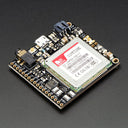Adafruit FONA 3G Cellular Breakout - European version
by Adafruit








For those who want to take it to the next level we now have a 3G Cellular Modem breakout!
The FONA 3G has better coverage, GSM backwards-compatibility and even sports a built-in GPS module for geolocation & asset tracking. This all-in-one cellular phone module with that lets you add location-tracking, voice, text, SMS and data to your project in a single breakout.
This module measure only 1.75"x1.6" but packs a surprising amount of technology into it's little frame. At the heart is a powerful GSM cellular module (we use the latest SIM5320E) with integrated GPS. This module can do just about everything
- Quad-band 850MHz GSM, 900MHz EGSM, 1800MHz DCS, 1900MHz PCs - connect onto any global GSM network with any 2G SIM.
- This is the European Version - with dual-band UMTS/HSDPA 900/2100MHz WCDMA + HSDPA
- Fully-integrated GPS (Qualcomm PM8015 GPS) that can be controlled and query over the same serial port
- Make and receive voice calls using a headset or an external 8Ω speaker + electret microphone
- Send and receive SMS messages
- Send and receive GPRS data (TCP/IP, HTTP, etc.)
- AT command interface can be used with 300, 600, 1200, 4800, 9600, 19200, 38400, 57600, 115200, 230K, 461K, 961K, 3.2M, 3.7M and 4.0Mbps
- Native USB support - plug it into a computer and you'll get serial ports for AT commands, GPS NMEA as well as a modem (note we've only tried out the AT&NMEA ports on Windows)
Here's the GPS specifications:
- 16 acquisition channels
- GPS L1 C/A code
- Sensitivity
- Tracking: -157 dBm
- Cold starts : -144 dBm
- Time-To-First-Fix
- Cold starts: 100s (typ.)
- Hot starts: 1s (typ.)
- Accuracy: approx 2.5 meters
We strongly recommend using an active antenna with the GPS, while you can get a fix with a passive antenna it takes a long time.
Please note! Adafruit had a lot of requests for a 3G cell module and they're happy to oblige but this module has many small differences between it and the FONA 800 and 808, so it is not a drop-in replacement! In particular the data functionality is not as easy to use. Adafruit are adapting their FONA library to support the 3G chipset and right now they have SMS, calling, and basic functionality working but it will be a while until they get full GPRS TCP/IP and HTTP support. Also, the GPS is not as fast and low-power as the one on the FONA 808. We recommend this module for people who are able to handle a more advanced experience. Beginners will like the FONA 80x series more.
Sounds great, right? So Adafruit kitted out this fine module onto a little breakout with all the extras you need to make your next project shine
- Onboard LiPoly battery charging circuitry so you can take your project on the go. Use any 500mAh+ LiPoly or LiIon battery and recharge over the MicroUSB when necessary. Two LEDs let you know when its charging and done
- Standard 4-pole TRRS headphone jack. Use any 'Android' or 'iPhone'-compatible headset with mic
- Breakouts for external 8Ω speaker and electret mic if you don't want to use a headphone
- Level shifting circuitry so you can run it with 2.8V to 5V logic.
- uFL connections for external antennas
- Indicator LEDs for power and network connectivity
- Standard SIM slides into the back
On its own, this module can't do anything. It requires a microcontroller to drive it! We suggest and use an Arduino but any 3-5V microcontroller with a UART can send and receive commands over the RX/TX pins.
You will also need some required & recommended accessories to make FONA 3G work. These are not included!
- Required SIM Card! A 2G or 3G Mini SIM card is required to do anything on the cellular network.
- Required Lipoly Battery - 500mAh or larger!
- MicroUSB cable for charging the battery and communicating with the module over USB
- External uFL GSM Antenna - this slim one works great (or, if you want to us an SMA antenna - a uFL to SMA adapter cable.)
- External Active GPS Antenna (needs a uFL to SMA adapter too) - like this one!
- TRRS 4-Pole Headset - Not required but it'll be tough to make a phone call without it. Any 'iPhone' or 'Android' compatible (but not iPhone original) should work. Adafruit tried about 10 different ones, and basically the more expensive once are more comfortable and louder but their official iPhone headset mic did not work.
Check out the tutorial with schematics, wiring diagrams, datasheets and more here!
TECHNICAL DETAILS
- Datasheets, schematic, EagleCAD PCB files, and Fritzing available in the product tutorial
- Product Dimensions: 50.0mm x 46.0mm x 7.0mm / 2.0" x 1.8" x 0.3"
- Product Weight: 50.0g / 1.8oz
-
Adafruit FONA 3G Cellular Breakout - European version
ADA2691£65.75
Shop with confidence – we've been serving the hobbyist electronics, Maker, and retro gaming communities since 2012.
- Satisfaction or refund guarantee
- Worldwide shipping via mail or courier
- 57,000+ customer reviews
- Secure website and payments
